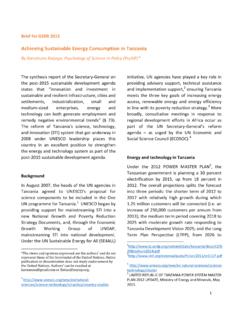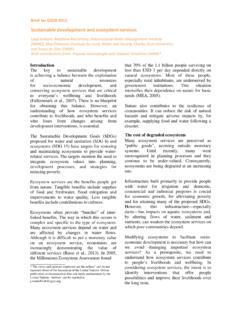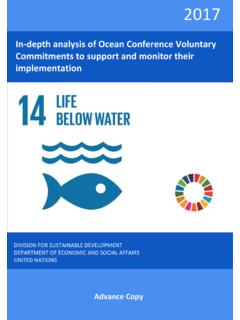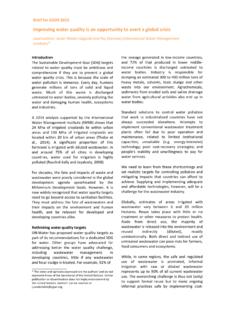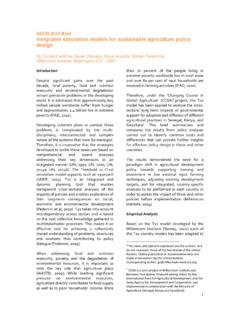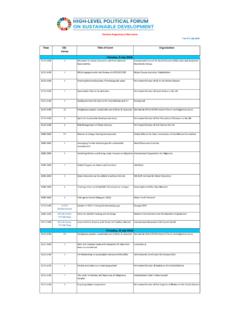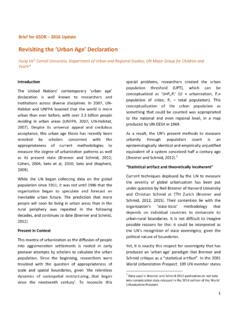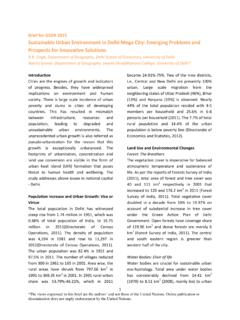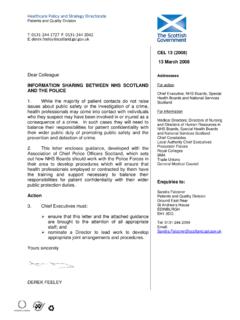Transcription of Measuring Progress on the SDGs Multi-level …
1 1 GSDR 2015 Brief Measuring Progress on the SDGs: Multi-level Reporting By Eve de la Mothe, Jessica Espey and Guido Schmidt-Traub, SDSN * In September 2015, heads of state will adopt Sustainable Development Goals (SDGs). The goals will chart out a universal holistic framework to help set the world on a path towards sustainable development, by addressing economic development, social inclusion, environmental sustainability, and good governance. The agenda laid out by the Open Working Group on the SDGs (OWG) in July 2014 is the main basis for the Post-2015 intergovernmental process, which began on 19 January From now until the September summit, Member States will further review the goals and targets.
2 They will also consider the means of implementation, the nature of a new Global Partnership, and a framework for monitoring and review of implementation. As underscored by the OWG, the focus of reporting on the SDGs must be at the national level. Each country will choose the indicators that are best suited to track its own Progress towards sustainable development. Yet, the Goals also describe a global agenda, including some global public goods that cannot be implemented by any country on its own. Success will require international coordination and collaboration, which in turn requires accountability and monitoring at global level.
3 In addition, regional monitoring and accountability will play a critical role in fostering regional collaboration and coherence in strategies to pursue the SDGs. A fourth and critical level of monitoring occurs in each thematic or epistemic community. The four levels of monitoring national, regional, global, and thematic are laid out in the Secretary-General s synthesis report. The report calls for a culture of shared responsibility, one based on agreed *The views and opinions expressed are those of the author(s) and do not necessarily represent those of the Secretariat of the United Nations.
4 Online publication or dissemination does not imply endorsement by the United Nations. 1 See conclusions of the sixty-eighth session of the General Assembly: universal norms, global commitments, shared rules and evidence, collective action and benchmarking for Progress . 2 This culture of accountability must be particularly strong at the national level, building on existing national and local mechanisms and processes, with broad, multi -stakeholder participation. National reporting National reporting should be the most significant level of reporting and will rely heavily on the work of National Statistical Offices (NSOs).
5 Given the breadth of the SDG agenda, it seems important not to limit national reporting to NSOs and to foster broad, multi -stakeholder participation in national National ownership at all levels of the SDG framework is critical, and national reporting must respond to national priorities and needs. For this reason, each country may pursue its own set of national indicators. Such a set of indicators may consist of the Global Reporting Indicators used to support the global monitoring framework and Complementary National Indicators that address each country s specific challenges, priorities, and The MDGs provide several powerful examples of how countries successfully adapted global indicators to suit their national priorities.
6 For example, Mongolia developed a 9th MDG on Strengthening Human Rights and Fostering Democratic Governance, which were seen as necessary preconditions for the achievement of all the other This new goal was supported 2 UN Secretary-General, (2014), The Road to Dignity by 2030: Ending Poverty, Transforming All Lives and Protecting the Planet, Synthesis Report of the Secretary-General on the Post-2015 Agenda, para 146. 3 UN Secretary General, (2014), para 146. 4 SDSN, (2015), Indicators and a Monitoring Framework for the SDGs, Draft Report, Paris, France and New York, USA: SDSN.
7 5 See UNDP Mongolia website: 2 by additional targets and indicators to track Progress towards democratic governance and human rights. The indicators included nationally specific measures, such as Expert evaluation of conformity of Mongolian laws and regulations with international human rights treaties and conventions (percentage), as well as perceptions-based indicators such as People s perception on press and media freedom. 6 Similarly, Bangladesh adapted the MDGs to meet local needs by setting new targets and indicators for promoting women in local government bodies, as well as separate targets on access to reproductive health services.
8 Continuing in this vein, Bangladesh prepared a detailed national proposal for potential SDG indicators in their 2012 MDG Given the greater breadth and universality of the SDG agenda, we expect that national adaptation of the goals, targets, and supporting indicators will play a bigger role than under the MDGs. Global monitoring As described above, global monitoring is a vital complement to national monitoring and reporting. Global monitoring will ensure global coordination, support strategies to manage global public goods, and indicate which countries and thematic areas are in need of greatest assistance.
9 A global dialogue on Progress will also encourage knowledge-sharing and reciprocal learning. To this end, a set of Global Reporting Indicators for the SDGs is required. The majority of Global Reporting Indicators will be derived from NSOs, drawing on official data sources such as censuses, civil registration and vital statistics, and household surveys, but some may be prepared by specialist agencies, for example where no suitable, comparable official data exists. To ensure comparability, Global Reporting Indicators must be harmonized across countries. We therefore recommend that each Global Reporting Indicator have at least one lead technical or specialist agency, responsible for coordinating data standards and 6 Government of Mongolia, (2009), The Millennium Development Goals Implementation: Third National Report.
10 7 See Annex 3: Government of Bangladesh Planning Commission, (2013), The Millennium Development Goals: Bangladesh Progress Report 2012. collection, ensuring harmonization, and providing technical support where necessary. Global Reporting Indicators should be limited in number to minimize the reporting burden on national statistical offices. Consultations with NSOs suggest that 100 Global Reporting Indicators represents the upper limit of what can be reported at a global Similar constraints exist at the level of the global statistical community, including specialist agencies, which will compile and harmonize the global datasets that inform the global review process.

